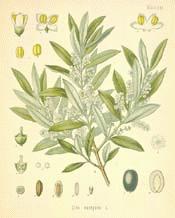
Botanical.com Home Page

|
Olive
(Olea Europaea LINN.)
Click on graphic for larger image
|
Olive
Botanical: Olea Europaea (LINN.)
Family: N.O. Oleaceae
---Synonyms---Olea Oleaster. Olea lancifolia. Olea gallica. Olivier.
---Parts Used---The oil of the fruit, leaves, bark.
---Habitat---Asia Minor and Syria. Cultivated in Mediterranean countries, Chile and Peru, and South Australia.
---History---The high position held by the Olive tree in ancient as in modern days may be realized when it is remembered that Moses exempted from military service men who would work at its cultivation, and that in Scriptural and classical writings the oil is mentioned as a symbol of goodness and purity, and the tree as representing peace and happiness. The oil, in addition to its wide use in diet, was burnt in the sacred lamps of temples, while the victor in the Olympic games was crowned with its leaves.
---Description---Olea europaea is a small, ever green tree, averaging 20 feet or more inheight. It has many thin branches with opposite branchlets and shortly-stalked, opposite, lanceolate leaves about 2 1/4 inches long, acute, entire and smooth, pale green above and silvery below. The bark is pale grey and the flowers numerous, small and creamywhite in colour.
The dark purple fruit is a drupe about 3/4 inch long, ovoid and often pointed, the fleshy part filled with oil. The thick, bony stone has a blunt keel down one side. It contains a single seed.
Being hardier than the lemon, the Olive may sometimes produce fruit in England. The largest of the varieties under cultivation is produced in Spain, but probably Italy prepares most oil, the annual average being 33 million gallons.
The beautifully-veined wood not only takes a fine polish, but is faintly fragrant, and is much valued for small cabinet-work. It was in olden days carved into statues of gods.
For use as a dessert fruit the unripe olives are steeped in water to reduce their bitterness. Olives à la Picholine are steeped in a solution of lime and wood ashes. They are bottled in an aromatic solution of salt.
In warm countries the bark exudes a substance called Gomme d'Olivier, which was formerly used in medicine as a vulnerary.
The large 'Queen Olives' grown near Cadiz are chiefly exported to the United States; the smaller 'Manzanillo' is principally consumed in Spain and Spanish America.
The trees bear fruit in their second year; in their sixth will repay cultivation, and continue as a source of wealth even when old and hollow, though the crop varies greatly from year to year.
The groves are cut until the beauty of the trees is lost.
The ripe fruits are pressed to extract the oil, the methods varying in the different countries.
Virgin Oil, greenish in tint, is obtained by pressing crushed fruit in coarse bags and skimming the oil from the tubs of water through which it is conducted. The cake left in the bags is broken up, moistened, and repressed. Sometimes the fruit is allowed to reach fermenting point before pressure, the quantity of oil being increased and the quality lessened. The product is called Huile fermentée.
Huile ordinaire is made by expression and mixture with boiling water.
Provence oil is the most valued and the most refined.
Official Olive soap is made from olive oil and sodium hydroxide.
[Top]
---Constituents---The exuding gum-resin contains benzoic acid and olivile. Mannite is found in the green leaves and unripe fruit. The oil, Oleum Olivce, non-drying, fixed, solidifies on treatment with nitrous acid or mercuric nitrate, is slightly soluble in alcohol, miscible with ether, chloroform or carbon disulphide. The specific gravity is 0.910 to 0.915 at 25 degrees C. or 77 degrees F. It is pale yellow or greenish-yellow, with a faint odour and bland taste, becoming slightly acrid. At a lower temperature than 10 degrees C. or 50 degrees F. it may become a soft, granular mass. Tripalmitin crystallizes and the remaining fluid is chiefly triolein. There are also arachidic esters and a little free oleic acid.
---Medicinal Action and Uses---The leaves are astringent and antiseptic. Internally, a decoction of 2 handsful boiled in a quart of water until reduced to half a pint has been used in the Levant in obstinate fevers. Both leaves and bark have valuable febrifugal qualities.
The oil is a nourishing demulcent and laxative. Externally, it relieves pruritis, the effects of stings or burns, and is a good vehicle for liniments. With alcohol it is a good hair-tonic. As a lubricant it is valuable in skin, muscular, joint, kidney and chest complaints, or abdominal chill, typhoid and scarlet fevers, plague and dropsies. Delicate babies absorb its nourishing properties well through the skin. Its value in worms or gallstones is uncertain.
Internally, it is a laxative and disperser of acids, and a mechanical antidote to irritant poisons. It is often used in enemas. It is the best fat for cooking, and a valuable article of diet for both sick and healthy of all ages. It can easily be taken with milk, orange or lemon juice, etc.
---Dosage---As a laxative, 1 to 2 fluid ounces.
---Adulterants---Cotton-seed, rape, sesame, arachis and poppy-seed oils are the many adulterants found, and several official chemical tests are practised for their detection.
---Other Species---The flowers of Olea fragrans or Lanhoa give its odour to the famous Chulan or Schoulang tea of China.
[Top]
Common Name Index
A MODERN HERBAL Home Page
Bear in mind "A Modern Herbal" was written with the conventional wisdom of the early 1900's. This should be taken into account as some of the information may now be considered inaccurate, or not in accordance with modern medicine.
© Copyright Protected 1995-2025 Botanical.com
| 
